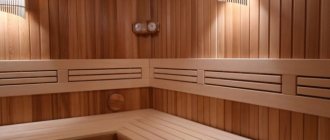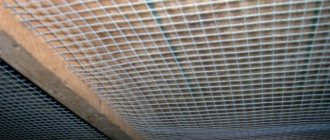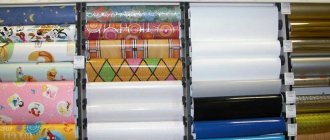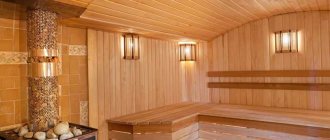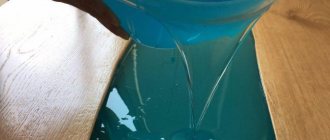The use of high-quality varnish for baths and saunas is considered one of the most effective ways to protect wood from swelling with moisture, material degradation and preventing the growth of pathogenic microflora. You can, of course, use the “old-fashioned” recipes and leave the lining as is, without covering, but such a sauna will require significant effort to clean, clean the walls and thoroughly dry the room.
In a Russian bath
The Russian steam room differs from the Finnish one in that there is more water here and the temperature is lower.
Yes, and ventilation can be in bursts and only (this is when the windows and doors are wide open). Consequently, a tree with a steam room finds itself in a situation where it gets wet, and it is difficult for it to dry out. It’s good if the owner throws the extra log into the stove after the procedures and lets the stove dry the bathhouse. It follows from this that impregnation for a steam room in a Russian bath would not hurt. Because what does a good (=safe) impregnation do? It reduces the moisture absorption of wood and closes its pores. As a result, it turns out that the surface is neither wetted nor absorbent.
ADVICE! Many people say that such impregnation does not last long. Well, if a long time is ten years, then yes, it is not designed for that long. In fact, it is worth renewing it either when you notice that the tree has ceased to repel water, or as a preventative measure after a year.
Since we are only talking about safe impregnations for the steam room, we will not include antiseptic ones. First of all, because they are water-soluble, and therefore, if they are used in a steam room, it is only before applying varnish that protects the impregnation layer from washing out. This can still be done in a sauna, but in a Russian bath...
Impregnation for baths and saunas Belinka Interier Sauna 0.75 l. Photo by Leroy Merlin
In principle, water-repellent impregnation for a steam room is sufficient in our opinion. In this case, there is less moisture and air in the tree, and these are the necessary ingredients for the appearance of both mold and rot.
Let's put it this way: oil impregnations are the arithmetic mean between “do nothing at all” and “make complete protection”. Of course, there are complaints about them, but you must immediately understand that not every impregnation is suitable for a steam room in a bathhouse.
What are the complaints? Well, water absorption still remains, this is not one hundred percent protection. It is only being reduced significantly. If you want to reduce it even more, varnish it.
And in our opinion, the best impregnation of the steam room is with linseed oil or a mixture of it with wax.
Flaxseed oil
First, let's be clear on one issue. Please be careful and don't forget:
IMPORTANT! Yes, there is drying oil, which is made mainly with linseed oil. But you shouldn’t use it to impregnate wood in a bathhouse.
Well, or where there is no elevated temperature. The fact is that to speed up the drying of even natural drying oil, various driers are added to it, which are harmful to humans. And besides natural drying oil, there is also drying oil made from petroleum, this one is even worse. In general, no drying oil in the steam room.
Pure flaxseed oil is easy to find on sale - in the same supermarkets or even in pharmacies.
Why is it used for wood? Because it refers to drying oils, that is, they form a polymer film over time. Moreover, this happens only in one direction - if polymerization has occurred, then the oil will not disintegrate back into monomers.
Flaxseed oil is used both raw and cooked. Cooking changes the rate of drying. When applying raw oil, you will have to wait three days for drying. For boiled it is less, but even drying oil with driers (substances that accelerate drying) dries for at least a day.
In this case, it is better to apply linseed oil not in one, but in several layers. You can imagine how long the processing will take. It is necessary to wait until it dries, because a film may form on the outside, but deep down the oil will not yet have time to polymerize.
They rub linseed oil into both the trim and the shelves, but we’ll talk about the latter below.
In general, the method is proven and has proven itself well as an impregnation for steam rooms and baths.
ATTENTION! The polymer film formed on the surface is not resistant to abrasion and mechanical damage. This only means that it needs to be renewed as it becomes damaged or worn out.
Renewal is not difficult - the same rubbing of oil into the wood as before. Cracks are eliminated and shine returns.
An equally common way to use linseed oil for impregnation is to create a mixture of it and natural beeswax. Depending on what consistency you prefer, you can create thinner (more oil, less wax) and firmer (vice versa) mixtures. You can start from the 1:1 ratio and then experiment.
If hard oil wax is applied, you can use a hair dryer (regular or construction) to improve absorption into the surface of the wood. True, there is one more life hack, purely for the bath: after applying the composition, heat the bath - everything will be absorbed under the influence of heat.
Types of bath varnishes
The market offers many different paint and varnish coatings, but not all of them are suitable for effectively protecting the wood of a bathhouse. Let's consider which varnishes are advisable to use to cover a bath, and which are undesirable:
Oil varnishes
- . They consist of natural and artificial resins, modified natural oils, solvents, and driers. The latter promote rapid drying. When applied, they form a durable yellowish film. Cost - from 2 thousand rubles per liter. Service life - 1-2 years.
Alkyd varnishes
. Contains pentaphthalic and glyphthalic synthetic resins and driers. They are usually dissolved with synthetic oils. They have higher technical characteristics than oil ones, but also a higher cost. Their price starts from 700 rubles per liter. Operational life is 2-3 years. It is this group that includes the common yacht and parquet varnish, but such a product forms a hard shell, and therefore its use for baths is undesirable.
Polishes and alcohol varnishes
. They contain natural resins. Not recommended for covering a log house. They form too hard a shell and do not protect well from precipitation. Price - from 1200 rubles per liter.
Alkyd-urea varnishes
. They are represented by a solution of amino-formaldehyde and alkyd resins, to which acidic hardeners are added. They perfectly protect the tree from negative factors. However, the film is not elastic, which will interfere with the natural processes in the wood. They can be used to cover the porch or wooden steps in front of the bathhouse. Cost - from 300 rubles per liter.
Acrylic varnish for baths
. Consists of polyacrylates and organic solvents. Ecologically pure. It is optimally suited for covering a log house and is relatively inexpensive - from 200 rubles per liter. Service life is about 5 years.
Polyester varnishes
. They form a thick film and provide maximum protection from the effects of humidity and temperature changes. They are distinguished by their high cost. Operational life is 3-4 years. Often sold in powder form. Price - from 500 rubles per kilogram.
- Water-based polyurethane bath varnish
. Appeared on the market not so long ago. It incorporates the advantages of polyester and acrylic compositions. Environmentally friendly and durable. When adding strengthening components, it lasts about 6-7 years. It is expensive (from 1200 rubles per liter), but is of high quality.
As for nitrocellulose and polyurethane varnishes, their use for a wooden bath is highly not recommended due to the too high hardness of the shell.
Many varnishes, although they have a transparent structure, still give the wood a tint. Think over this point in advance or consult with a consultant at a hardware store so that the result completely satisfies you. If you are choosing a tinted varnish, then you need to carefully calculate the amount of product you will need so that you do not have to buy more. Otherwise, you can make a mistake with the shade. Even from the same manufacturer, varnishes from different batches may differ slightly in shade.
Is it possible to varnish the inside of a bathhouse? Varnish for baths and saunas: characteristics. Bath and sauna varnish
Let's take a closer look at whether it is possible to varnish the inside of a bathhouse.
.
To improve surface properties, use bath
Only high-quality ones should be carried out indoors so as not to cause harm. At the same time, work on different surfaces is somewhat different; therefore, they will be considered separately.
_
Room
- a unit of a real estate complex (part of a residential building, other real estate object associated with a residential building), allocated in kind, intended for independent use for residential, non-residential or other purposes, owned by citizens or legal entities, as well as the Russian Federation, constituent entities of the Russian Federation Federations and municipalities. ; - space inside a building that has a specific functional purpose and is limited by building structures. (SNiP 10-01-94); - a space inside a house that has a specific functional purpose and is limited by building structures. (SNiP 31-02-2001)
Treatment of sunbeds and benches
Products are selected that penetrate deep into the wood without forming a film. They should not cause burns or irritation to the skin. Oil solutions applied with brushes are well suited for this.
Treatment of walls and ceilings in the steam room
To withstand the harsh conditions of this room, it is preferable to choose acrylic or water-based varnish for the steam room in the bath; such products will be safe. It is necessary to work carefully, treating the entire surface well.
How and with what to treat the floor
There are no sauna floor varnishes from Russian manufacturers on the market; as a result, special sauna floor boards are often purchased that have already undergone the necessary treatment. Among similar products, one can highlight Neomid bath and sauna varnish. If ordinary boards were used, they are coated with special protective acrylic agents; they must be mixed with water before work.
Varnish for saunas and baths: varieties and selection criteria
Due to its transparent structure, which emphasizes the natural grain of the wood, many people prefer to use bath varnish to cover the structure; colored coating is not so popular for these structures. At the same time, it is important that the paint and varnish material is highly elastic, because wood has the ability to expand and swell.
There are several types of sauna varnish; compositions with wax are popular. Products vary in their characteristics, knowledge of them will help you make a confident choice.
It is important that the paint material is highly elastic.
Acrylic varnish for baths and saunas
Acrylic varnish for baths and saunas for interior decoration is safe and has better durability compared to water-dispersed solutions. For these premises, products are produced containing elements against natural influences and dry quickly.
Acrylic varnish for baths and saunas for interior decoration is safe and has better durability compared to water-dispersed solutions.
Water-based sauna varnish
Water-based varnishes are widely used for steam rooms; they impregnate wood well, are resistant to high temperatures, and do not emit harmful components. But this coating does not last long; every two years the structure will have to be re-coated.
Water-based varnishes are widely used for steam rooms; they impregnate wood well and are resistant to high temperatures.
Oil bath varnishes
The oily texture of the product creates a good layer that impregnates and protects the wood from moisture, resulting in the formation of a film. But they emit a strong odor, for this reason they are not entirely suitable for painting the inside of steam rooms. It is better to choose them for external finishing and surface covering in the dressing room.
The oily texture of the product creates a good layer that impregnates and protects the wood from moisture, resulting in the formation of a film.
How and with what to cover the shelves so that the coating lasts longer?
The durability of the coating on a wooden surface depends not only on the composition of the product applied, but also on the tool used, application conditions, number of layers, etc.
What is better to process - tool
If you purchased a store-bought product for bath shelves, the instructions will tell you what to use. However, there are not many options.
Either it will be a brush (pay attention to the instructions - in some cases they write that it should be made of natural bristles), or a clean cloth. In some cases, you can use a spray
Again, different impregnation compositions can be either ready-to-use or require heating.
If you use homemade impregnation, then before starting work you need to heat it to 50-60 degrees.
The brush is used only if the impregnation is sufficiently liquid. The stripes it applies should not overlap so that “steps” are not created (this applies to hardening impregnations). The brush is very convenient for applying oils.
A rag is better for waxing. When rubbing the thick mixture, try to distribute it evenly, but you don’t have to remove the excess right away. If, after applying the layer, you heat the oven, then there will be a classic “waxing” - the wax itself will spread as it should. (When waxing items not for a bath, they are heated with a hairdryer or burner.)
How many layers
The number of layers of impregnation is also usually specified in the instructions. Since the means are different, we will only venture to roughly name the number of layers and the time interval between them. Let's say it's two coats applied one hour apart.
The number of layers depends on both the properties of the impregnation and the porosity of the wood. The more pores, by the way, the higher the consumption of the product - it can increase by about two times.
ADVICE! Take your time to use the soaked shelf. Give it at least a day to absorb. Longer is better, because the point of using polymerizing oils is to let them dry. It's like oil painting - when the paint dries, the layer hardens completely.
Regarding the drying time: they are also different, in some cases a day is enough (according to the instructions), in others the time can last up to two weeks.
How often should the coverage be renewed?
The answer to this question depends on what tool you used. The fact is that oil impregnation, although it is easier to apply than wax impregnation, also lasts much less than the latter.
So, for renewing a layer of oil impregnation, the period is called from six months to 2 years, and for wax impregnation - several years (without specification).
However, you should focus on the condition of the wood. If you used tinted impregnation, then you can see from it exactly where it came off. If the impregnation is colorless, focus on the condition of the wood - has it become wetted with water and swollen from it? In these cases, of course, there is no need to wait for the time promised by the manufacturer.
What is better bath varnish or impregnating oil?
Both types of materials are quite popular in folk or amateur “sauna building”. A wooden bathhouse building must be protected from water vapor and fungal formations, so a variety of impregnations and polishes are used - from furniture polishes to ship oils. At the same time, few future sauna owners think about the effectiveness and safety of the impregnating material.
Before making your final choice, consider the following:
- Good oil intended for treating wooden surfaces inside a bathhouse is expensive, more than 30 Euros per liter, and the dressing room, floor and ceiling of the steam room will have to be treated every season. As a result, a considerable amount accumulates;
- Using, as some would-be experts advise, purified transformer oil, costing $2/l, turns out to be cheap, but unsafe. According to statistics, baths and saunas soaked in oil burn out three to four times more often than those treated with varnish;
- Oil, unlike varnish, whether water-soluble or polyester-based, does not provide a waterproof film. Hot air and water vapor lead to thermal oxidation and decomposition of hydrocarbons.
All this evaporates under the influence of temperature, so everyone who is in the steam room has to breathe in the impregnating vapors. If you can’t find a good varnish for the sauna, then it’s better to leave the walls as is. You will have to spend more effort and labor on cleaning, but visiting the bathhouse will be guaranteed to be safe for your health.
Of course, varnish resins and mixtures vary greatly in composition and resistance to hot water vapor. In addition, indoor bath varnish should not emit toxic substances, such as styrene or toluene-based solvents. According to experts, high-quality varnish for saunas and baths, intended for treating walls in a steam room, should not contain mineral additives and complex stabilizer salts, which are always abundant in oil impregnations.
Features of protection of different parts of the steam room
Of course, you can saturate the entire steam room and the furniture in it with one composition. And then coat it with one varnish. Moreover, the products currently produced are rarely limited to one protection function. They usually combine, for example, impermeability with antibacterial effects. But the conditions affecting different parts of the steam room are still somewhat different. Therefore, the processing requirements are also different.
Ceiling
Perhaps the least requirements are placed on this part of the steam room. It is exposed only to the temperature effects of steam. Water almost never reaches it. Therefore, it can simply be coated with a specialized bath varnish.
The ceiling in the bathhouse must be reliably protected from dampness and temperature. Source eco-ceiling.ru
Floor
Unlike the ceiling, all the water that is used in the steam room ends up on the floor. Therefore, the anti-water protection for floor boards must be very good. In addition to antibacterial and anti-water impregnation, it is advisable to cover the floor with a protective layer of varnish. But not every varnish is suitable for the floor. The protective layer should not be slippery. This is a must to protect the floor. Of course, the soles of your feet should not stick to the floor. Do not think that repeatedly coating the floor with varnish increases its safety. The thick layer of varnish cracks and water reaches the wood. In addition, the wood cannot “breathe” through such a coating and will still deteriorate.
When building a bathhouse, do not forget about impregnating the logs on which the floor boards are laid. This, of course, is not the inside of the bathhouse, and there are no special protection requirements for them. But if water gets to them, then sooner or later the floor inside the bathhouse itself will suffer, no matter how well it is protected.
Walls
Most of the impregnation for the bathhouse inside is spent on protecting the lining, which is usually used to line the walls. Therefore, you should not use impregnations and varnishes that, when heated, can release strong-smelling substances. And do not cover it with a protective layer that does not allow the wood to “breathe.”
Improper use of protective compounds can lead to the regular appearance of condensation on the walls of the bathhouse. Source synteko.in.ua
Shelves and benches
The shelves are the main part of the entire steam room, for which it is, in fact, built. Lying on it should be comfortable, pleasant and safe for health. Wood is a poor heat conductor, so even at high temperatures you won’t get burned by it. It’s another matter if it is covered with a protective film, which can cause a burn if touched. Therefore, it is not recommended to use paints or varnishes for it. It is better to apply a special impregnation for the bath. Often such impregnations are wax-based.
The requirements for the safety and convenience of the surface of shelves and benches are so high that there are bathhouse lovers who believe that wood should be natural for them and not covered with anything at all. But this is still suitable for small bathhouses, where simple shelves can be replaced. And when real furniture masterpieces are built, it is better to find a high-quality composition and ensure their durability.
It’s not enough to create beauty - you also need to protect it. Source m.yukle.mobi
Varnishing
Varnish is the final stage of covering wooden floors in any room. The bathhouse is no exception. The difficult operating conditions of this room impose certain conditions on the finishing material:
- protecting the surface from rotting, enhancing the effect of the antiseptic;
- protecting the coating from various damages, especially mechanical ones;
- should not pose a threat to humans and domestic animals;
- moisture resistance;
- should not overheat and emit harmful substances.
How to paint a floor using varnish:
- Prepare the surface. Floors should be cleaned of dust, grease stains, and traces of old coating. Using wood putty, correct any unevenness. Be sure to treat with an antiseptic.
- Apply varnish using a brush or roller and let dry. It is important to remember that in the steam room you should use special varnishes that do not emit hazardous substances when heated. They must also protect the premises from fire as a result of sparks from the fireplace.
Preparation
To apply the varnish correctly, you must adhere to the following recommendations:
- Exposure to direct sunlight should be avoided.
- The surface should be free of dirt and any stains.
- For hard wood, use white spirit solvent.
- Roughness must be removed by mechanical grinding.
- For surfaces that have previously been painted with other paints and varnishes, it is necessary to ensure the compatibility of the paints. For this purpose, it is recommended to do a test painting on a small area.
- The painted surface does not need to be primed. However, it is worth inspecting it carefully and making sure that there are no varnish peelings. If there are detachments, they need to be sanded.
- Fresh wood materials require pre-treatment with a solvent.
- After sanding, remove any remaining dust. It is recommended to use a vacuum cleaner for this.
- Immediately before applying varnish, wipe the surface with a damp sponge or rag.
What is not suitable for treating bathhouses?
Acrylic water-borne varnish for baths and saunas, intended for exterior facade work, is definitely not suitable. Such materials are inexpensive, but apart from their decorative qualities, bright shine and beautiful tone, they are of little use. It is possible to open the outer walls, but the treatment procedure will need to be carried out annually, while branded coatings remain on the facade of the bathhouse without updating for an average of 5-7 years.
You should not use furniture varnishes to treat walls; they peel off easily and become cloudy when the wooden base is heated or slightly moistened. Any varnish compositions for industrial use should not be used for the interior of baths and saunas. Such materials contain salt adhesives that can cause a severe allergic reaction. The foundation or closed load-bearing elements of the bathhouse structure are treated with polymers.
Purpose of urethane varnish
Urethane varnish is intended for interior use and is used to treat wooden surfaces that are subject to high-intensity mechanical stress (doors, window frames, parquet and wooden floors, furniture elements, lining)
An important function of the varnish coating of these surfaces is also their protection from moisture and decorative finishing.
Colors available in the range: clear, oak, chestnut, pear, marigold, rosewood, walnut, mahogany, Oregon, teak.
When laying new parquet flooring or updating the appearance of parquet in old houses, the use of such a highly effective product as alkyd-urethane parquet varnish will be indispensable. This varnish not only serves to protect wooden flooring from adverse external influences and improve its appearance, but can also be successfully used to give additional strength to stairs, doors, windows and furniture made of natural wood.
Main properties of alkyd-urethane varnish:
1. The varnish composition is completely ready for use.
2. Varnish strengthens the treated wooden surfaces, increases their service life, and also emphasizes the natural beauty and structure of the wood fibers.
3. Urethane varnish provides ease of application and a uniform, uniform finish.
4. The varnish coating of wooden surfaces, obtained using alkyd-urethane varnish, is characterized by high resistance not only to mechanical stress, but also to contact with water and chemicals.
5. Alkyd urethane varnish dries quickly: each coat requires 12-24 hours to dry. The varnish coating dries completely within 1 week, and after 2 weeks you can lay out the carpet and arrange furniture.
Neomid - varnish for baths, saunas
"Neomid" is an acrylic-based composition designed for effective protection and decorative finishing of wooden elements in these rooms. Forms a translucent layer that protects against dirt and moisture, as well as various fungal deposits. This is a quick-drying, environmentally friendly, water-soluble acrylic varnish for baths, saunas, practically odorless, after drying it is able to retain a natural woody smell and emphasize the natural structure of wood.
The composition includes acrylic dispersion, targeted and bioprotective additives, defoamer and water.
What's in it, what are they made from?
Unfortunately, most manufacturers do not want to reveal their secrets, sharing information with the consumer about the composition of their products. This is probably done because the ingredients are simple and affordable, and not everyone will want to pay for fancy packaging if it significantly increases the price.
(For example: do you know that caustic soda, which is part of almost all strong anti-fat products, can be bought much cheaper in its pure form? And this is the main active ingredient, other surfactants and fragrances are just there for company.)
From what we have been able to find out about, say, shelf oils, the expression “natural ingredients” hides polymerizing oils (most often linseed and hemp) and waxes. In addition to them, paraffin is also mentioned. In this regard, the question arises: what prevents you from making such impregnation yourself?
Can I do it myself?
Of course you can. And many do just that. Here is one of the possible recipes suitable for the steam room:
The proportion between linseed oil and wax is 92:8, 93:7, 94:6, 95:5. That is, we take 92-95 parts of oil and 7-5 parts of beeswax.
The oil must be prepared first. To do this, it is boiled for 20 minutes. During this period of time, excess water evaporates from it and the characteristic odor disappears.
After boiling is completed, wax is added, which should be crushed in advance. As the mixture cools, it should be stirred to prevent the wax from curdling.
It is better to store the finished mixture in a glass container. Shelf life - no more than a year.
Well, for those who prefer not to bother with preparing oil wax, we will name the most well-known companies that make good impregnations of this type.
Which manufacturers and brands are good?
We will consider as good those from whom they take more often, whose names are well known to everyone.
First of all, as usual, I would like to name the Finns and the Germans.
TIKKURILA and TEKNOS are well-established Finnish companies. The first offers Supi Saunasuoja and Supi Laudesuoja impregnations to protect shelves. The second one has Satu Saunasuoja.
The German company ESKARO offers Saunaoil.
Slovenian BELINKA offers “Sauna Oil – PARAFFIN”. By the way, drying occurs within a day.
Among the Russian manufacturers we will name PINOTEX, SENEZH, NEOMID.
What to consider when choosing impregnations
Some impregnations contain substances that, when heated, are actively released into the environment and can cause poor health. Therefore, they can be used in any room of the bathhouse, except for the steam room. This applies to synthetic-based substances - they can be used in rooms with a normal microclimate and temperature (rest room, dressing room). Compositions for treating wood in the steam room and washing room must have an organic basis.
Wooden coverings can be protected from moisture by:
- Varnish coatings. But they are not suitable for the steam room. As a decorative layer and protection from high humidity, varnish on the floor can be used in rooms with high traffic - a dressing room and a rest room.
- Impregnations. These are colorless compositions containing phytoncides. They suppress and prevent the occurrence of fungus and mold.
- Antiseptics containing fungicides are applied under the paint.
When purchasing a composition, you must read the instructions; usually there is a note on the package stating that the impregnation is intended for use in baths and saunas.
Acrylate-based antiseptics
With the help of such compounds you can not only protect the tree, but also give it a new shade. Acrylic impregnations are destructive for most pathogenic organisms. Before applying this composition, it must be diluted with water.
Such compositions have the following advantages:
- They are not afraid of temperature changes, so they can be used in any bathhouse.
- They are not afraid of moisture and have water-repellent properties.
- They are vapor permeable, that is, they do not clog the pores of the wood.
The acrylate-based antiseptic SENEZH “Sauna” is very popular. It is specially designed for comprehensive protection of wood in saunas and baths. The antimicrobial effect ensures the destruction of viral bacteria.
Impregnation for wood on an acrylate basis "SENEZH Sauna"
Features of the material include:
- Long-term protection of wood from negative influences in difficult microclimates.
- Preventing the spread of infections.
- Eco-friendly safe composition.
- No smell.
- Water- and dirt-repellent properties.
- Preserves the natural aroma of wood and ensures its vapor permeability.
- Creates a moisture-resistant protective layer.
- Does not affect the change in wood shade.
- Prevents wood from deforming when repeatedly wet and dry.
- Has fire-resistant properties.
"SENEZH Sauna"
Is it possible to treat the floor in a bathhouse with drying oil?
After application, the drying oil polymerizes and a durable protective film appears on the surface, which does not allow moisture to pass into the wood. It is recommended to use drying oil on a natural basis in the bath, and especially in the steam room. When heated, it will not release toxins or odor.
The composition of natural drying oil includes vegetable oil - tung, linseed, sunflower and others. Sold as a clear oily liquid. When applied, it does not “clog” the pores of the wood.
It is convenient to apply drying oil with a brush
Types of floors
Rooms with high levels of humidity are combined with two types of flooring:
Concrete floors are used in washing rooms and steam rooms. Tiles are laid on top, which should be non-slip, suitable for areas with high traffic and high humidity. To prevent bare feet from coming into contact with cold concrete, special wooden grilles are also installed. This option is preferable because it allows you to maintain cleanliness and avoid the formation of mold. To do this, the grates are taken out to dry from time to time and coated with special antiseptic agents.
For wooden floors, thin beams or boards are used, which are laid on logs made of a similar material. This type of flooring is recommended for use in a waiting room, as well as in a recreation room. The use of wood requires careful antiseptic treatment and waterproofing.
What type of wood is used for baths? Exclusively coniferous species. They do not get hot enough to squeeze out the resin that is contained in the pockets and pores of the wood.
Natural impregnation remains inside and thereby extends the life of the tree, preserves its quality, and provides reliable protection.
Experienced builders do not recommend using hardwood, especially oak, for bathhouse floors. Oak, despite its durability and strength, is quite slippery.
How to make a floor in a bathhouse
Traditionally, the floor structure in a bathhouse is a plank flooring laid on logs. The material used is spruce, pine, larch and fir wood. These are moisture-resistant durable woods with a natural antiseptic in their composition. One of the advantages is that when wet, floors made from these types of wood do not slip, which is not the case with oak planks.
When installing a wooden floor, its design is of great importance. The floor can be poured or not leaky. In the first case, the boardwalk is installed with gaps between the slats through which water flows freely. In the second case, water flows into the sewer through a special hole in the floor.
Concrete floor with drain and plank drainage on top
Concrete floors are strong and durable. At the same time, when pouring the screed, it is necessary to insulate it. The screed is mounted with a slope towards the drain hole.
Practical modern materials for arranging the floor in a bathhouse are ceramic tiles and stone. This is a waterproof, durable material. The disadvantage is the cold surface. Therefore, a portable pourable boardwalk is laid on the floor, which can be taken out of the room to ventilate and dry.
Tiles on the floor in the steam room
How to paint depending on the room
Well, we have already partially begun to cover this question above, but now it’s time to more clearly distinguish what kind of room we are talking about.
In the dressing room and rest room
We see no reason to distinguish these two rooms. The fact is that most owners of country baths have a dressing room size (if they have one at all) that is quite modest. And purchasing separate materials so that you have something to paint the floor in the bathhouse waiting room is somehow redundant, or what?
Unless there is some kind of different covering than in the rest room.
Wooden floor in the dressing room
We strongly doubt that anyone would want to leave a concrete floor in the rest room and dressing room. And there are not many options. The only alternative is wooden. So let's talk about it.
Do I need to treat wooden surfaces in a steam room?
If you built a sauna using the right technologies, you probably insulated the steam room from external cold as well as moisture. After taking care of the wood from the outside, do not forget to treat the internal components of the steam room, because this will increase the strength and durability of any structure in the bathhouse.
The center of the steam room is the shelf where visitors spend most of their time, so it must be durable and safe. Despite the fact that wood is a material that is not resistant to moisture, it is usually used to build a shelf, which, if done incorrectly, will last no more than a year.
To achieve strength and long service life of the shelf, it is necessary to choose the right wood, as well as treat the finished product with a suitable impregnation, which can be made on the basis of natural or artificial components.
First we should talk about the choice of wood. The following types of wood are excellent for structures inside the steam room:
- Alder is an ideal material for a steam room, but it is difficult to find on the market;
- Linden is an inexpensive but high-quality material with a soft texture, great for steam rooms;
- Aspen is also an excellent tree for a bathhouse with high moisture resistance (more details: “Which aspen is best for a bathhouse - planning a log house”);
- Oak, ash, abash sedela, ofram and miranti are expensive wood species that are rarely used for finishing baths.
There are cheaper alternatives, such as pine or spruce, but they have a number of disadvantages and the savings are small, so it is recommended to use the above wood, which has good moisture resistance and is easy to process.
Next, it’s worth talking about treating the shelf with special compounds. Before treating the shelves in the bathhouse and sauna, you should think about whether it is worth doing. It is impossible to give a definite answer, so we will help you resolve this issue by providing some facts:
- Long-term contact of human skin with poor-quality impregnation can lead to unpleasant consequences, for example, a rash;
- If the steam room has excellent ventilation, then the shelves can simply be sanded;
- An untreated shelf can quickly turn black and develop mold on its surface.
Properties of varnish
Bathhouses and saunas are special rooms where the temperature is not just high, but real heat. Therefore, varnish for baths and saunas must have, according to consumers, certain properties:
- be as resistant to large temperature changes as possible;
- meet all fire safety requirements;
- protect wood on walls and floors from mold, fungi and other pathogenic microorganisms;
- not to lose over time its external aesthetic appearance, original texture and color.
As a rule, bath and sauna varnish contains a high-quality acrylic base, which makes it resistant to high temperatures and prevents this product from melting. Also, such varnishes always contain wax, which gives the composition properties that repel water and dirt.
When choosing a high-quality coating for wood, be sure to remember that the varnish must be easy to clean, easy to apply to the surface and have high adhesion.
Popular formulations
Finnish "Tikkurila"
Tikkurila is a well-known company not only in its homeland, whose products are often chosen by Russian residents. With all the wealth of choice of its other products, Tikkuril sauna and bath impregnations are quite few in number, and it would not be difficult to list them:
- Supi Laudesuoja is the same paraffin oil mentioned above. It is intended to cover only the shelves with them.
- Supi Saunavaha - the composition is not fully indicated, but the manufacturer says that it contains natural wax. Can be used not only for shelves, but also for walls, ceilings, doors and window frames.
Sauna impregnation Tikkurila Supi Saunavaha for baths and saunas, colorless 0.9 l. Photo Petrovich
There are also a couple of acrylate compounds - these are water-based varnishes, which already contain antiseptics, although only against mold and blue stains. The names are: Supi Arctic and Supi Saunasuoja. Both are suitable for walls and ceilings and should not be used for floors.
ATTENTION! Finnish impregnations for baths and saunas do not differ in variety at all. If you look at Teknos products, it turns out that they are the same, only the serial name Supi must be replaced with Satu.
"Neomid"
is also familiar to many thanks to its advertising. She has a variety of antiseptics that are suitable for internal and external work, as well as for protecting wood used in particularly difficult conditions (we are talking about contact with water and soil).
But these are antiseptics that are suitable for use in residential and non-residential premises, not only in the bathhouse. Among the specialized products, there is such impregnation for baths as “Neomid 200” and “Oil for baths and saunas”.
"Neomid 200" is an antiseptic that can be used anywhere inside the bathhouse, including on the shelves.
Water antiseptic for baths and saunas Neomid 200 Proff 1 l. Photo by Leroy Merlin
“Oil for baths and saunas Neomid” is an impregnation for baths against moisture and rotting at the same time. Let us explain: usually they exist separately and are applied in different layers. First, the wood is impregnated with an antiseptic, and only water-soluble ones are used inside the bath, and then it is coated with oil or paint. Here it’s “two in one” – both oil and antiseptic. In any case, this is what we understood from the characteristics given on the manufacturer’s website.
There is also a wood bleach “Neomid 500” - it can also be called an impregnation. It is used when the surface of the wood has darkened or become stained with mushrooms. In this case, the treatment leads to an almost instantaneous change in color to the original one.
: "Aquatex" and "Eurotex"
Those who are hearing about these impregnations for the first time may want to watch the video we found. It describes their properties and scope of application:
GOL sauna
Many people know Palizh tinting materials and paints from the Udmurt company “New House”. She also has a GOL series, one of the directions of which is impregnation for baths and saunas GOL Sauna. There is everything you need for a bath - impregnation for the shelf, another impregnation for walls, ceilings, doors and windows, and a third for the floor.
The manufacturer claims that all formulations simultaneously protect against moisture and fungi. Impregnation for baths and saunas is an acrylic coating. The one intended for the floor is already an alkyd composition, that is, paint based on organic solvents. Well, the one for the shelves is some kind of secret product containing “natural wood softener.”
The readers have the same request - if anyone has used it, tell us about your impressions.
"Estate 409"
A very budget option for acrylic coating with an antiseptic included in it is impregnation for baths and saunas “Usadba 409”. That is, you don’t even need a primer - fungicides and insecticides are already included in the composition. In addition, it contains a tannin inhibitor, a substance that causes wood to darken over time.
In general, we can say that this is cheap acrylic paint or varnish (and cheapness here, by the way, is not at all an indicator of poor quality, rather an indicator of mass and therefore cheap production), to which everything possible has been added.
It's supposed to be usable everywhere except shelves and floors (that's what we think). Moreover, it is specially designed for wet rooms, therefore the steam room and washing room are the main candidates for painting with “Usadba 409”.
In our opinion, this is a very competitive option. The Finns also calmly add antiseptics to their acrylates. Another question: do their compositions match? But here you can trust the manufacturer’s certificates, if he has them and demonstrates them to the buyer.
As for color, the impregnation is colorless and there are no colors for it. Maybe it's for the better
Basic properties
Bath and sauna varnish "Neomid", according to user reviews, has many positive properties, such as:
- formation of a durable protective dirt- and water-repellent translucent layer with increased elasticity;
- ensuring protection of the wooden surface from the formation of fungi and mold, thanks to the special bioprotective additives included in its composition;
- preventing darkening of the wood surface;
- preserving and emphasizing the natural structure of the tree;
- quick drying on the surface;
- the product is environmentally safe;
- practically odorless;
- water-soluble varnish for baths and saunas;
- tinted.
Thanks to the listed advantages, this varnish for baths and saunas received the most positive reviews.
Used for varnishing ceilings, walls and other wooden surfaces inside saunas and baths, except floors and shelves.
